The Revolver Faithful convened again at Gunsite Academy in Paulden, Arizona, the weekend before Thanksgiving 2024, for the Pat Rogers Memorial Revolver Roundup. I was fortunate to be there again for this outstanding training and social experience, and would love to take you on a quick tour of how the “Roundup” unfolded from this man’s point of view.
Editor’s Note: Things got busy at the end of the year and there was no room in the editorial calendar for this one, as we pushed out the Christmas-related material. I hope you’ll enjoy this review, even if it’s a bit tardy!
-Mike
Hard Work
The planning for this years’ Roundup started right on the heels of last year’s successful rendezvous. While I was quite happy with the execution of last year’s program, Roundup captains Darryl Bolke (“DB”) and Bryan Eastridge (“Y”), of American Fighting Revolver, wanted to improve on the student registration and training experiences for 2024.
The first place they started was with a schedule update. In 2023, the training calendar included a pair of two-hour blocks in the morning, and another pair of two-hour blocks in the afternoon, which was designed to promote an increased number of training opportunities, but actually resulted in a loss of training time, as instructors and students moved between assignments. In 2024, the Roundup schedule was simplified to include a single, three-hour instruction block in both the morning and afternoon, and the result was exactly as intended—more training time, and less logistical and transportation chaos.
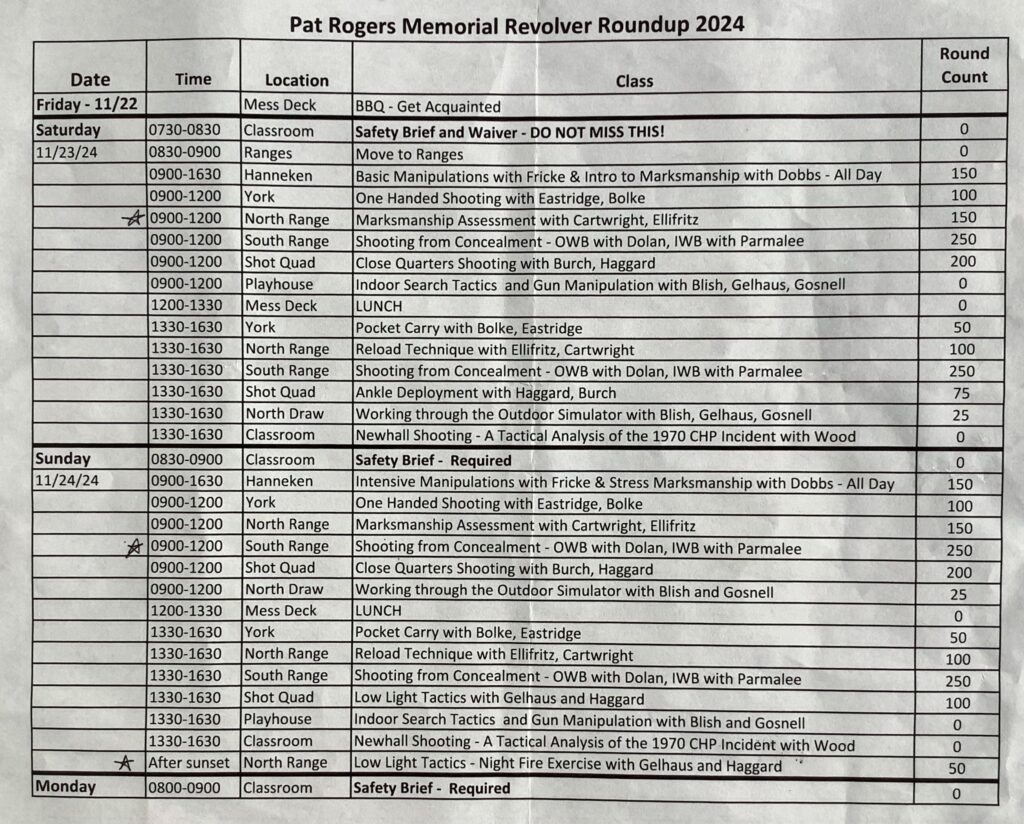

Additionally, the oft-hectic management of student registrations and class assignments was updated in 2024 through the dedicated work of Bill Foster, who used his considerable talents and energy to streamline the processes. For 2024, Bill moved the management of the Roundup away from a manual system, with all its inherent complexities and delays, towards an electronic system powered by the PracticScore app. Bill’s effort resulted in a much smoother registration process, and better control of the bodies that showed up for each class.
I was super impressed with how well everything worked this year, and think we owe DB&Y and Bill a huge Thank You for their management of the busy program!
A Great Start
The kick off to the weekend started Friday, with a welcome BBQ that brought almost 120 registered students, a dozen-plus staff instructors, and another dozen-plus vendors together for an evening of fellowship and fun. The BBQ was primarily sponsored by the Firearms Trainers Association, with a little help from Simply Rugged Holsters, Wilderness Tactical Products, and Tuff Products. The students were treated to brats and dogs off the grill with all the fixings, and Michael Bane’s secret BBQ bean recipe, which he and sidekick Marshal Halloway had been working on all afternoon.
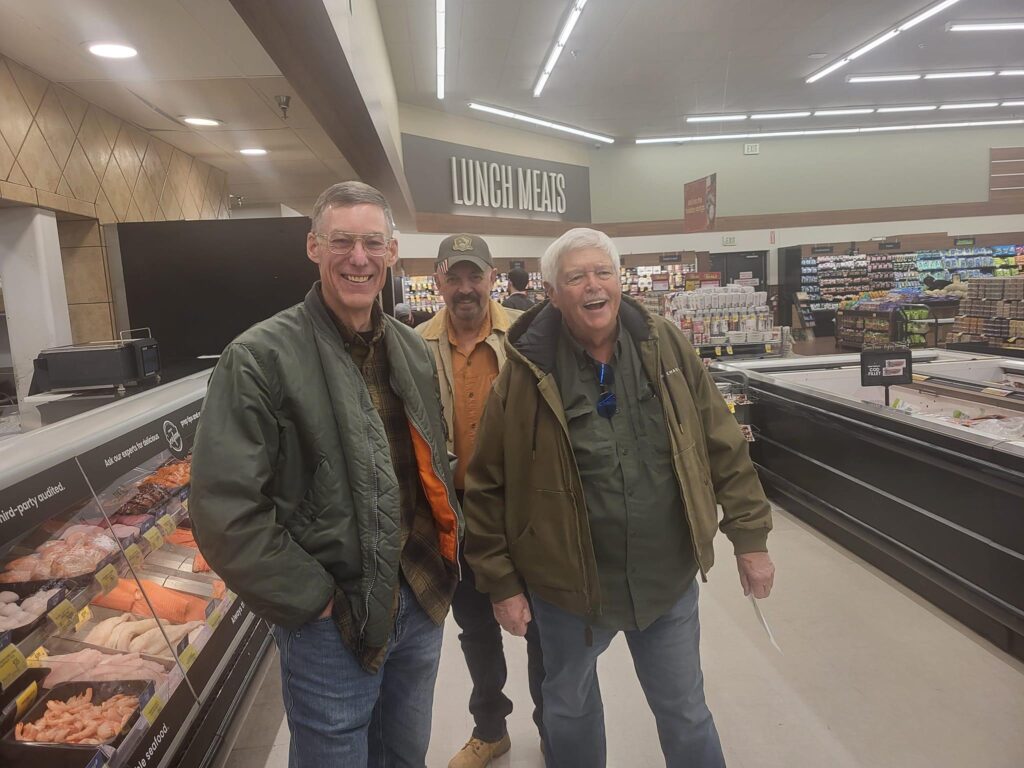
DB welcomed everyone to the Roundup, laid out the game plan for the weekend’s activities, and introduced all the instructors. We spent the night trading stories about the latest guns and gear we’d bought and shot, and eagerly awaited the start of training the next morning.
First Shots
I spent Saturday morning in Bruce Cartwright’s “Marksmanship Assessment” class, on the North Range of Gunsite. For those who don’t know Bruce, he’s a retired federal agent, an accomplished firearms instructor, and the owner of SAC Tactical, a firearms training school. Bruce was accompanied by his son, Will, and his staff instructor, Jack, and they led us through a series of marksmanship assessments designed to gauge our proficiency as shooters (and knock off a little rust, along the way).
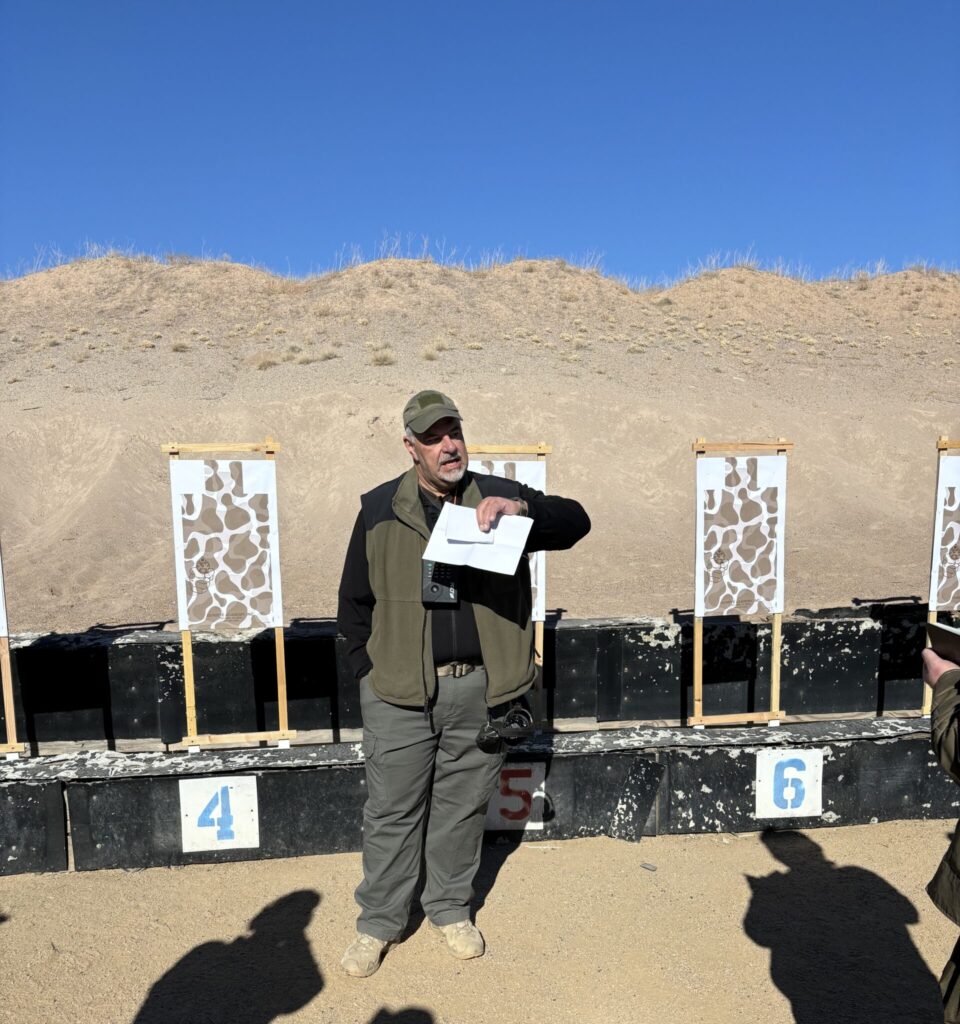
We started with some dry presses, then moved on to a shakedown drill that involved three rounds fired at five yards, three rounds fired at ten yards, and four rounds fired at fifteen yards on a B-8 target. I shot a 96/100 on this drill, and was happy to get off to a good start.
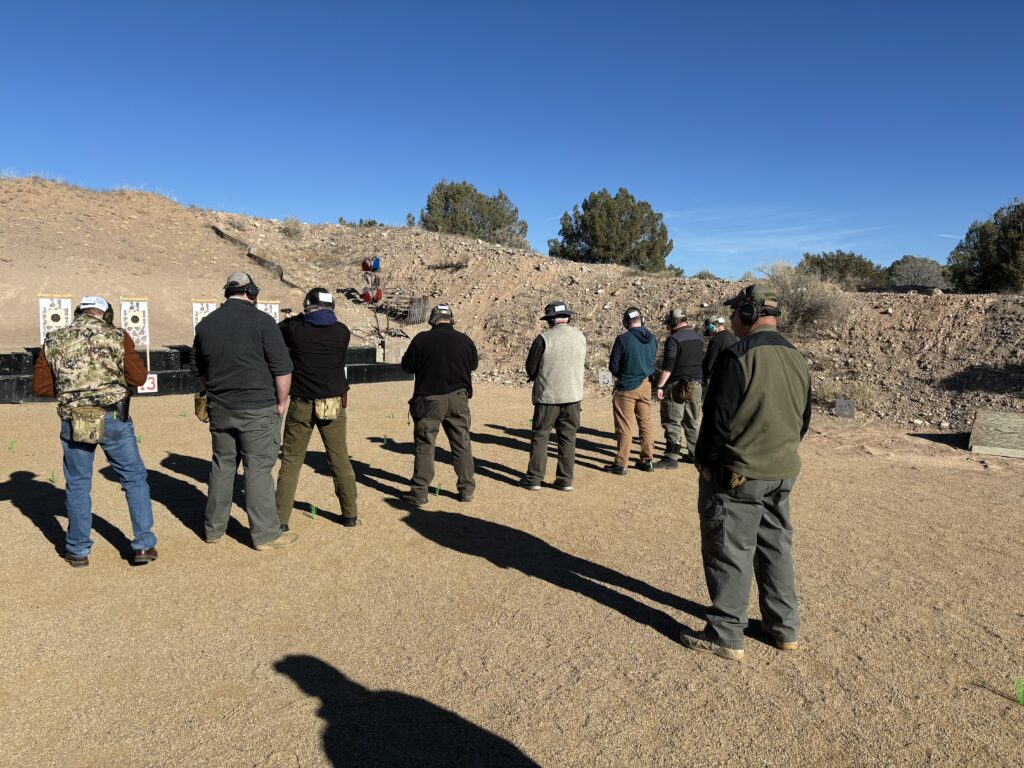
Bruce and his instructor team offered corrections and advice, and we moved on to the FBI Bullseye Course, which was a staple in the Bureau’s training “back in the day,” and provides an excellent look at your marksmanship skills. The 30-round FBI Bullseye Course is made up of the following course of fire, in which each stage is started from Low Ready:
-
-
- Slow Fire: 25 Yards, 10 rounds fired in 4 minutes;
- Timed Fire: 15 Yards, 5 rounds fired in 15 seconds. Repeat, for a total of two runs;
- Rapid Fire: 15 Yards, 5 rounds fired in 10 seconds. Repeat, for a total of two runs.
-
Bruce advised that agents were required to shoot a minimum score of 210/300 on the course to achieve a passing score, and firearms instructor candidates were required to shoot a minimum score of 260/300 on the first day of class to remain in the program, or they were sent home.
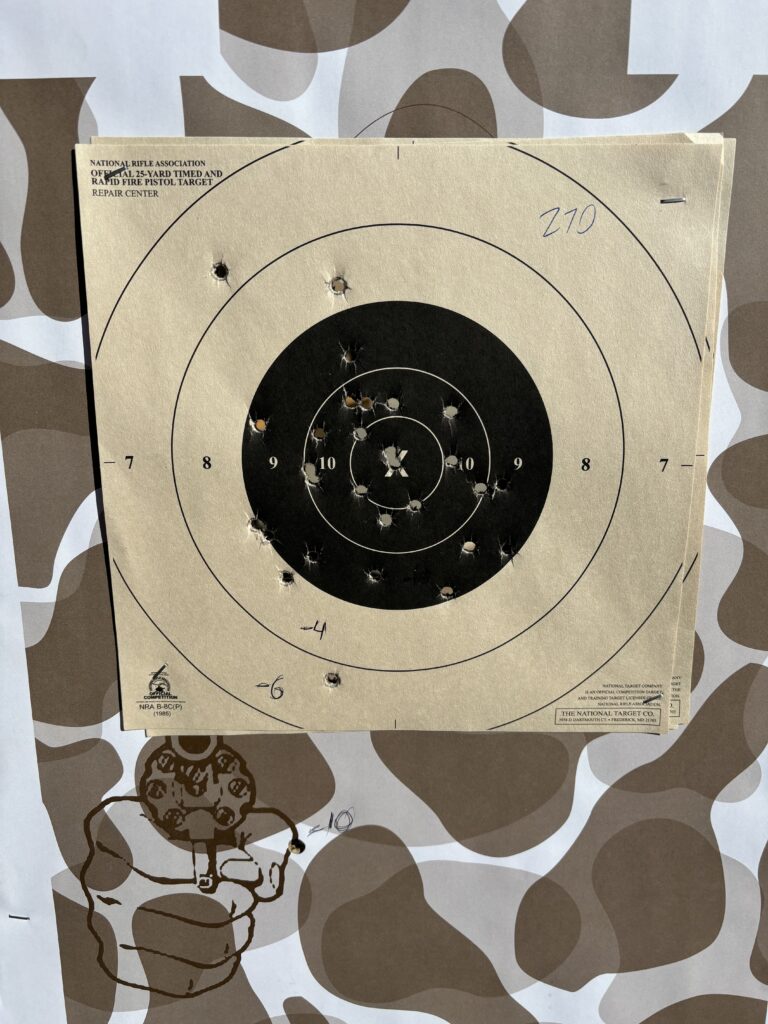
I was able to shoot a 270/300 on the course, with an “aw s#!t” that slipped off the bottom of the target and cost me 10 valuable points (I called it, too, as soon as I let it go–Argh!) As I kicked myself for the error, I heard Will describing to the class that they “needed to accept failure and have a good relationship with it,” because we had to fail in order to learn. I thought that was valuable advice, and also appreciated Bruce’s caution that, “the last 20% of the trigger press is the most important, so don’t rush it—be smooth, straight through the press.”
I’d get a chance to test the theory again on the FBI Double Action Course, which we shot next. The course of fire for this one, in which each stage is shot with the gun starting in the holster, looks like this:
-
-
- 5 Yards, 2 rounds fired in 3 seconds. Repeat 4X, for a total of 5 reps;
- 7 Yards, 2 rounds fired in 3 seconds. Repeat 4X, for a total of 5 reps;
- 7 Yards, 10 rounds fired in 20 seconds, including a timed reload;
- 15 Yards, 2 rounds fired in 3 seconds. Repeat 2X, for a total of 3 reps;
- 15 Yards, 4 rounds fired in 4 seconds;
- 25 Yards, 5 rounds fired from Kneeling in 10 seconds. Repeat 1X, for a total of 2 reps.
-
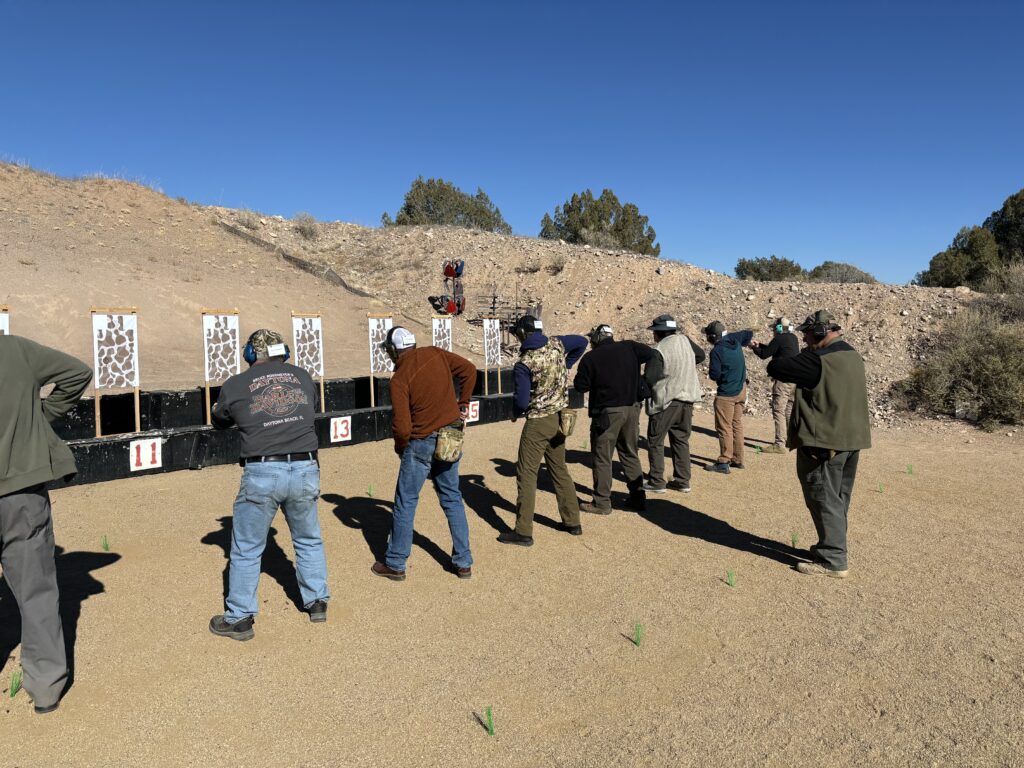
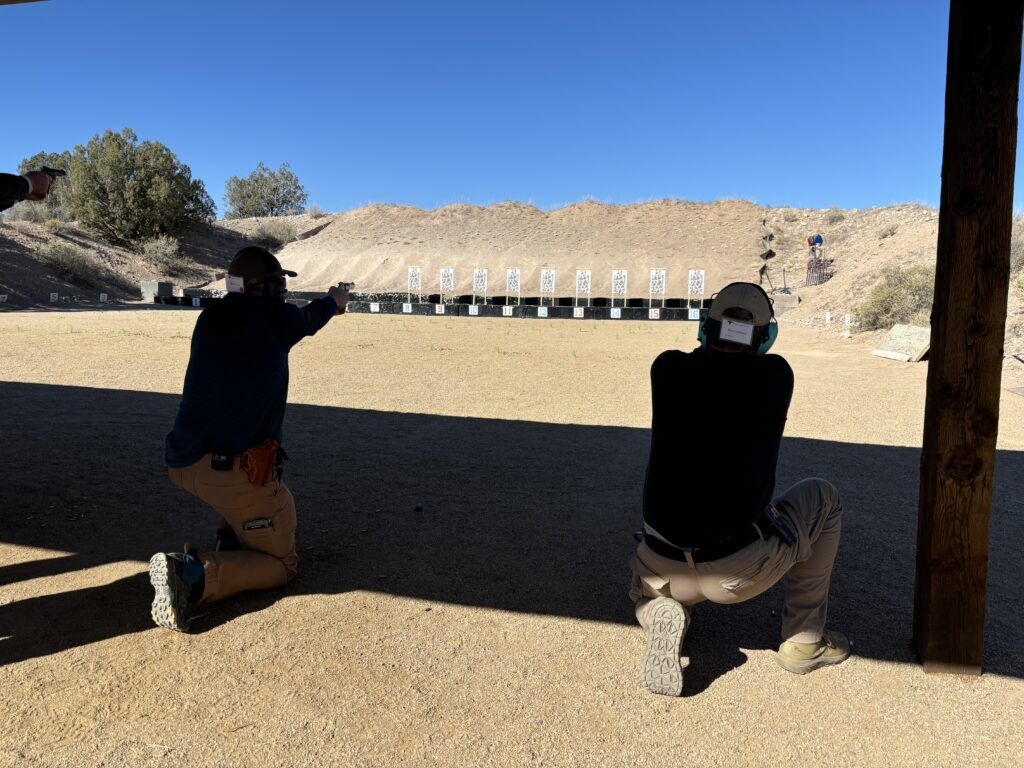
A passing score on the FBI Double Action Course is a minimum of 40 hits on the silhouette. I made all my hits, but some of those 25 Yard kneeling hits strayed a little far for my tastes, and I determined to shoot this drill (and the Bullseye Course) occasionally to see if I could tighten up my game.
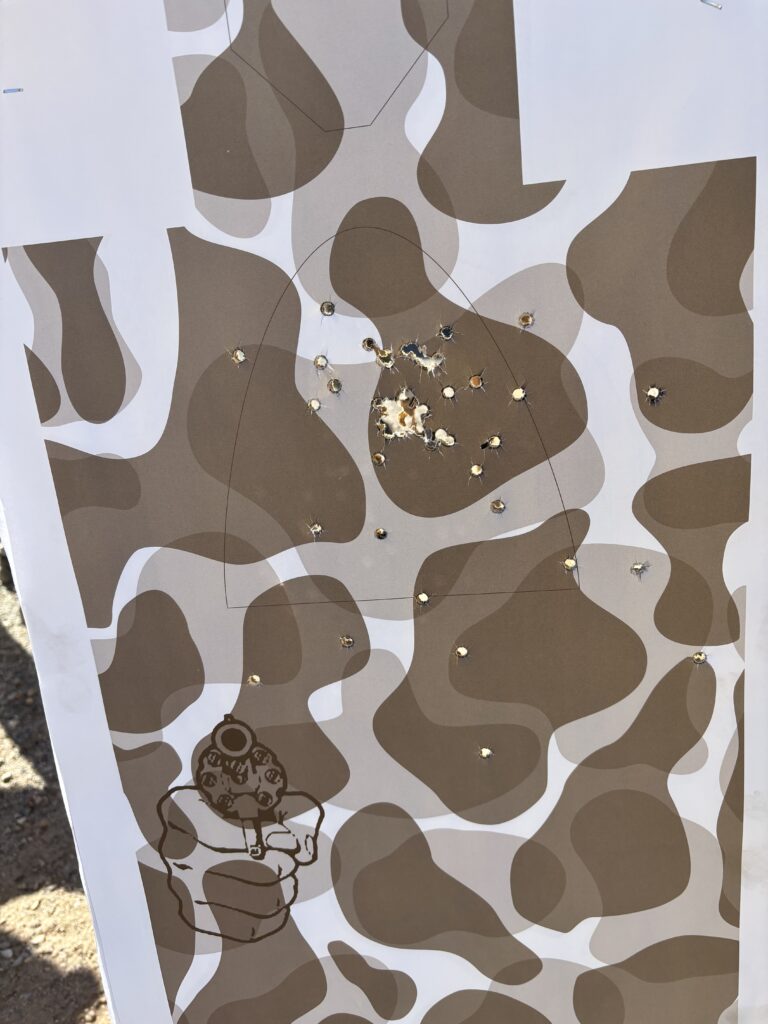
By chance, I happened to meet High Desert Cartridge’s Steve Shields during a break in the instruction. Steve is a retired career lawman and firearms instructor who’s producing some outstanding ammunition in all the calibers that make RevolverGuy hearts go pitter-patter. The students at the Roundup were shooting lots of his .32s, .38s, and .357s, and had great things to say about them. You’ll be hearing more about Steve and his outstanding ammo in these pages soon.
classroom
With the morning session finished too quickly, I grabbed a quick lunch (provided by a local caterer, who did a wonderful job feeding us all weekend from a broad menu of choices) and got ready to spend the afternoon in the classroom.
On Saturday and Sunday afternoons, I was fortunate to have the opportunity to deliver a three-hour presentation on the April 1970 California Highway Patrol gunfight in Newhall, California. It was really quite an honor for me to speak at Gunsite, and I was humbled to be on the stage that had hosted so many influential and talented teachers in our gun world. Thank you DB&Y, Sheriff Ken Campbell, and Dave Hartman, for the opportunity! I sincerely appreciated your trust in me.
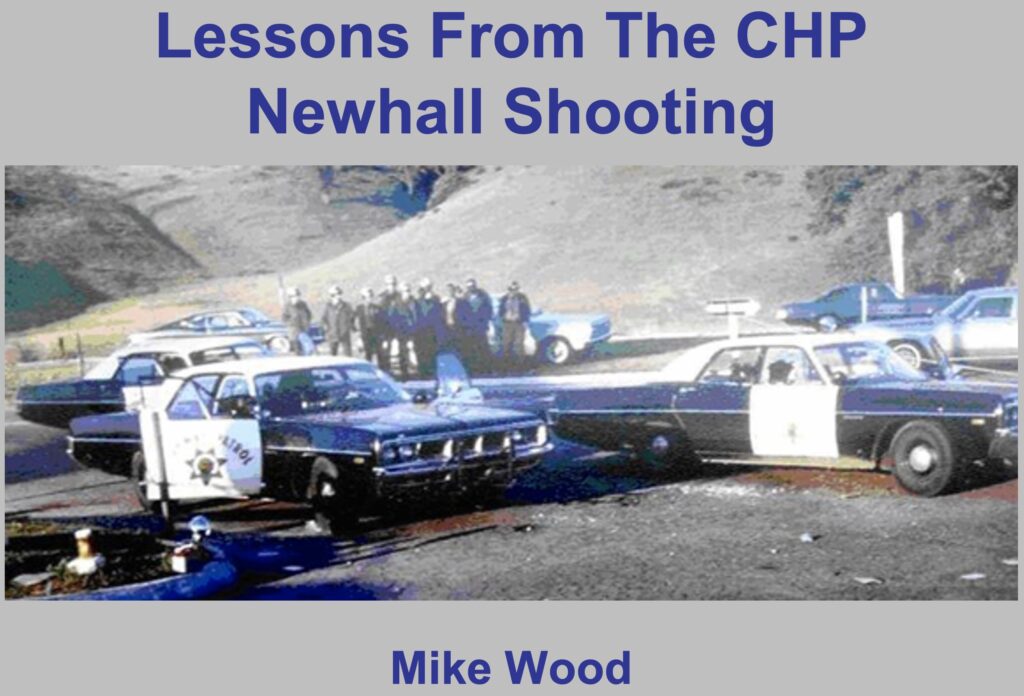
I spent the first hour of my presentation providing a detailed narrative of the gunfight, and the back two hours discussing important lessons to be learned from the fight, organized according to the Priorities of Survival model that I’m so fond of (and which I’ve written about in these pages before).
We discussed critical points about Mental Awareness & Preparedness, Tactics for the armed citizen, Skills and skill development/training, and Equipment issues. We covered lots of ground and it was an information-packed experience for the audience. I thoroughly enjoyed getting to share my work and research in these areas with the Roundup crowd, and was grateful to receive such positive feedback from them.
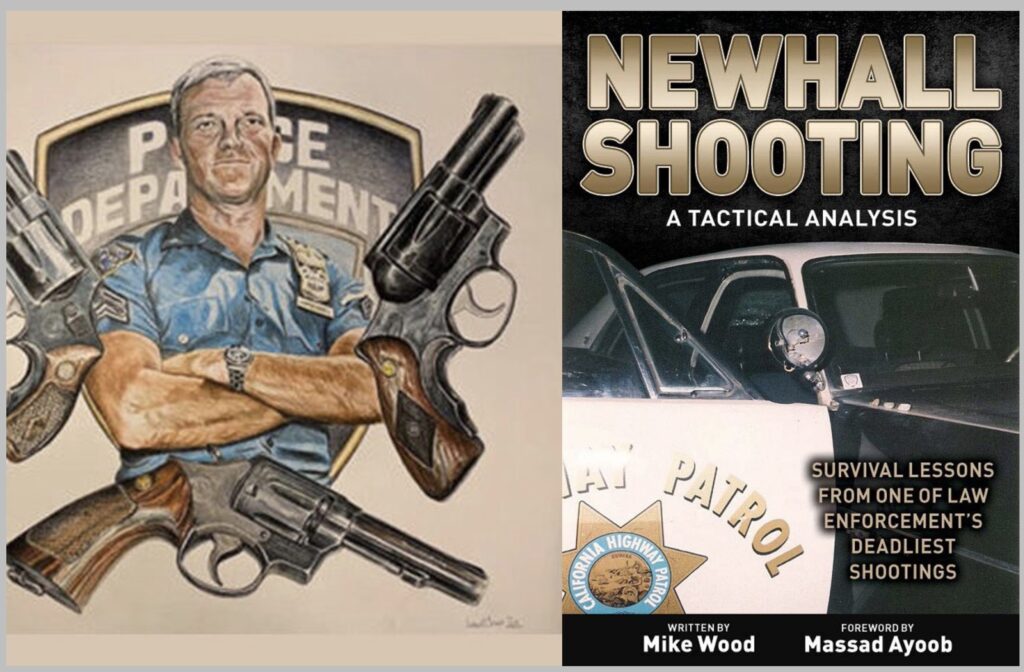
We added a third session on Monday afternoon at the request of the students, to accommodate all those who missed the briefing on Saturday and Sunday while they were on the range. The Monday session was also heavily attended by members of the Gunsite and Roundup staffs, and by friend Michael Bane, who was very kind in his review of my presentation as part of his podcast coverage on the Roundup. I was proud to put on a good show for all of them and, once again, to be invited back to the Gunsite stage. Quite an honor!
More Shooting and Learning
On Sunday morning, I was happy to attend the “Shooting from Concealment” training session hosted by LAPD lawmen Dave Dolan and Bill Parmalee.
One of the neat things about the Roundup is that students get access to a variety of trainers, including ones like Dave and Bill, who don’t normally teach public enrollment classes. Their law enforcement background and real-world tactical experience heavily influence their instruction, and the students benefit from it.
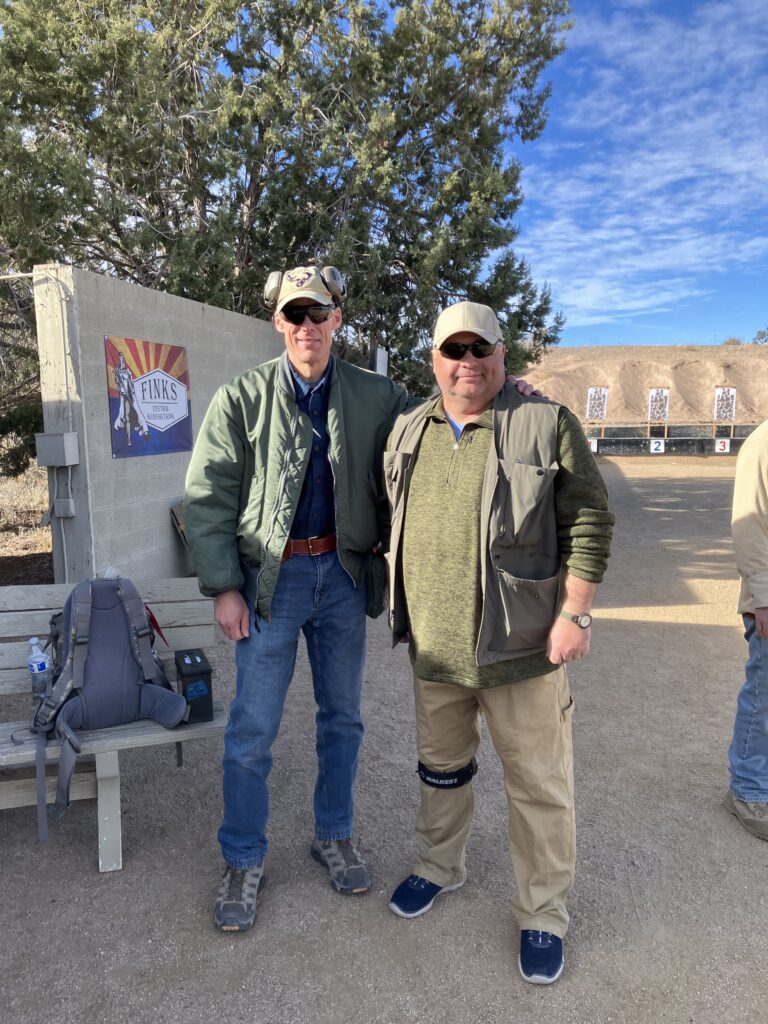
Dave and Bill’s honest discussion about the use of force in today’s perilous legal and social environment was more useful than any of the shooting exercises we accomplished later in the morning, because if you don’t have your mind right, your skills and gear don’t matter. The pair did an excellent job of setting the stage for the reality of armed self-defense, and gave everyone much to think about before they launched into the shooting instruction.
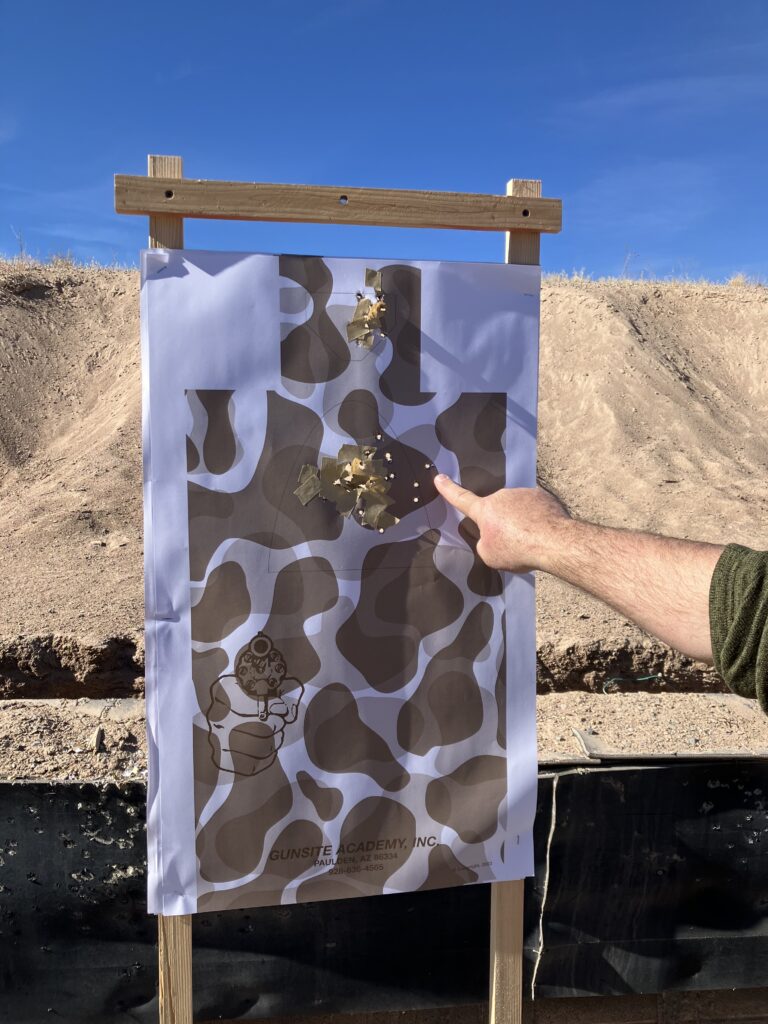
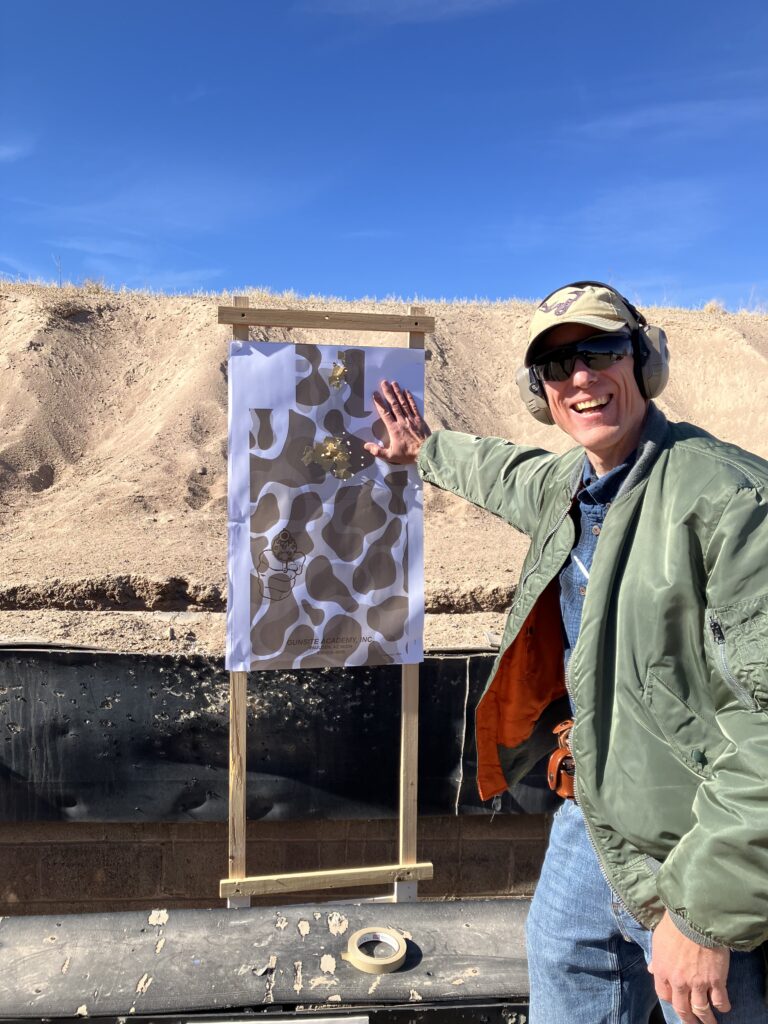
The shooting exercises that Dave and Bill led us through were characterized by rapid fire engagements at short distances, after moving “off the X.” We fired from retention up close, and in some exercises we were required to “create space” as we fired, to allow more extension of the arms and weapon. One handed (both strong and weak) shooting and alternative target areas (particularly the brainstem) were emphasized throughout.
This was combat-oriented training from men who had spent their lives in that arena, and had seen what works and what doesn’t. It wasn’t fancy or complex; There were no secret ninja moves or other nonsense. Instead, we got a serving of the essentials–how to hit hard, fast, and accurately at close range. It was a program of instruction based on hard lessons acquired during long careers of policing a tough city.
This was tough old guy territory. Social media influencers and self-impressed, “tactical” 20-somethings with no life experience need not apply.
When the lights go out
On Sunday night I was able to audit the Low Light Tactics and Night Fire Exercise conducted by Erick Gelhaus and Chuck Haggard. Since I was teaching during the afternoon on Sunday, I missed the mandatory preparatory course, but it was still useful to watch another set of instructors lead their students through the material, and see how the students responded to it.
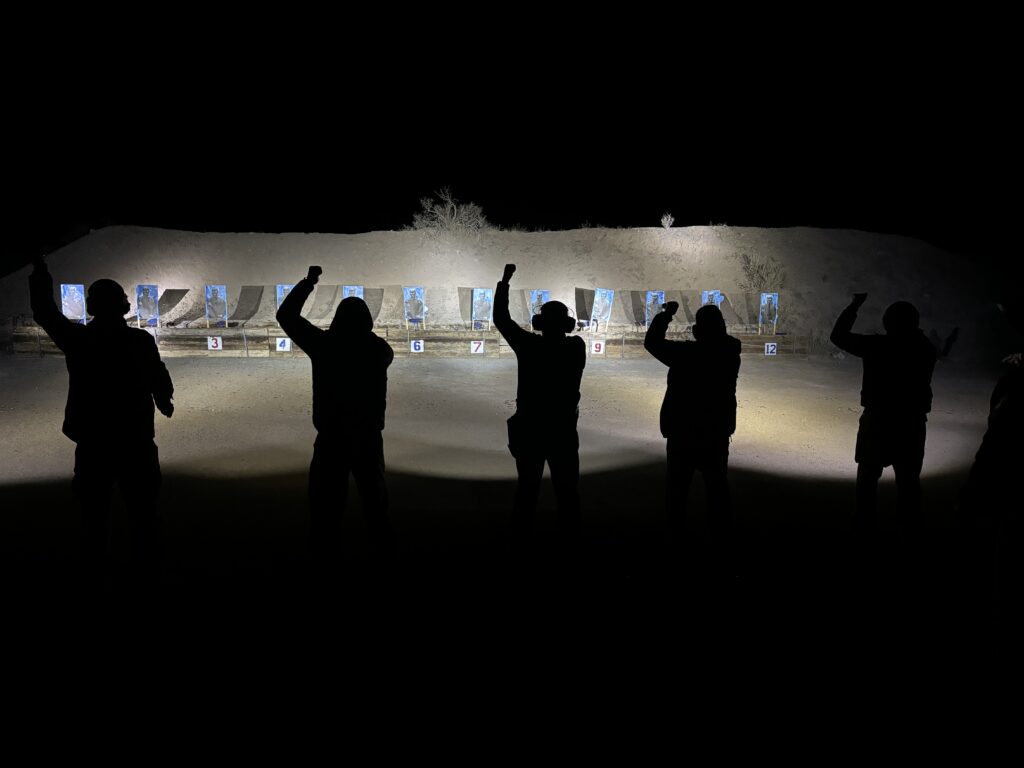
The attendees were able to practice a variety of search, identification and shooting techniques with hand held lights in a Crawl-Walk-Run format that began with dry fire and culminated with live fire exercises.
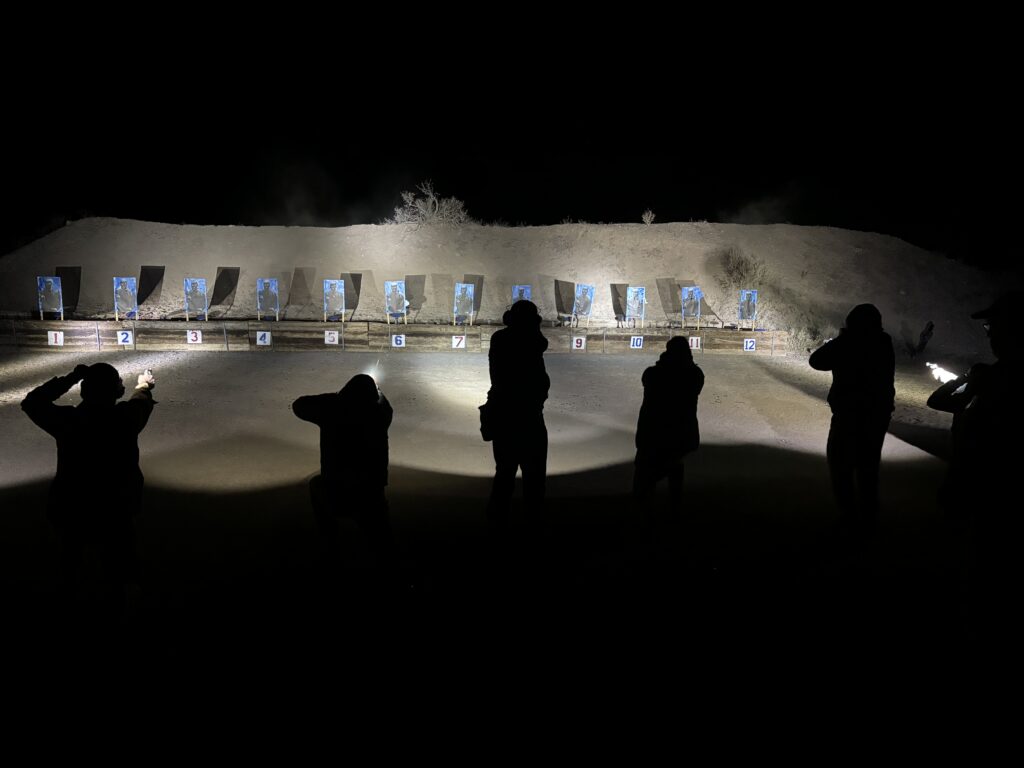
There are few places where students get the opportunity to shoot in actual low light conditions, but they do at the Roundup. It’s another example of how the Roundup is more than your average training experience.
Free Day
Monday at the Roundup is a special day, where the schedule is more flexible and students are encouraged to float around between scheduled activities, which are run more like Open Houses than formal courses.
I began my morning with a visit to Greg Ellifritz, who was running his “10-Round Proficiency Test” for all who wanted to give it a try. I’d been sorely disappointed to miss Greg’s instruction on Saturday and Sunday afternoons while I was teaching, and didn’t want to leave the Roundup without a chance to see him in action.
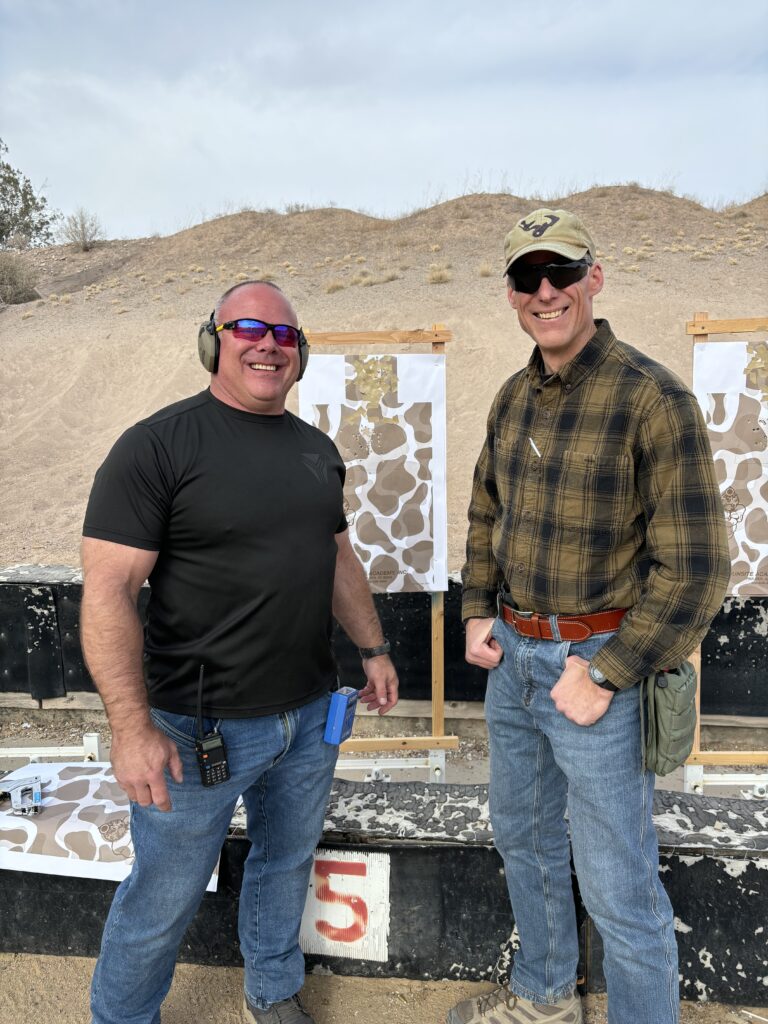
Greg’s 10-Round Proficiency Test was fired on a B-8 target (or just the head box of a silhouette, as we used) from the Low Ready position at five yards. When the timer beeped and started the clock running, the shooter was expected to fire the following sequence, without pause:
-
-
- Fire one round, with a two-handed hold;
- Transfer the gun, and fire two rounds, Left-hand only;
- Transfer the gun, and fire two rounds, Right-hand only;
- Conduct a reload, on the clock;
- Fire five rounds, rapid fire, with a two-handed hold.
- When the last shot is fired, the timer stops and the hits are counted.
-
Greg says he’d like his students to be able to get all ten hits in under 20 seconds, but holds himself to a 15 second maximum with 100% hits.
On my first run through the drill, I got all my hits in 17.8 seconds with my S&W 640 and an HKS speedloader, but my trigger control suffered a bit and my hits were all pulled right of center. A second attempt with the same gear netted a well-centered group in 15.69 seconds, which made me much happier.
Greg says he likes to use the drill at the beginning of practice as a diagnostic, to determine what he needs to work on. If his Left-hand performance doesn’t measure up, he’ll focus on that for a bit, or if his reload isn’t clean, he’ll emphasize that in his training session. I think that’s a great way to use the drill, and I also like the idea of running it cold at the start of a session to get a good measure of where you’re really at.
WANDERING
After finishing with Greg, I took a quick trip over to Mark Fricke’s range, where he and Chuck Haggard were getting ready to shoot a bunch of ammunition into Clear Ballistics gel from snubs. This is always a popular Monday morning exercise at the Roundup, and he had quite a crowd there. I only stayed a few minutes, but it was good to see the setup, after reading Mark’s results from prior Roundup shoots.
I then went over to Gunsite’s South Range, where a variety of new guns were available to test fire. I got the chance to shoot Colt’s new Viper (a 3” version), the Ruger LCR in .32 H&R (a nifty pairing), and the Taurus 650 (which made my S&W 640 heart flutter). A 4” blued Colt Python was also available, along with a S&W UC J-Frame of some flavor.
Of the three guns I fired, I was most impressed by the Colt Viper, which was wearing Hogue rubber stocks in lieu of the factory wood stocks. The Hogues felt great on the gun, and I’d be sure to replace the OEM stocks with a set just like them, if I bought my own sample. I found the Colt to be handsome, exceptionally smooth in its function (I think Bryan had been inside this sample, already), and very accurate with the supplied Federal 130 grain American Eagle ball. Kevin recently completed an extensive review of this outstanding gun, and I’ll probably run it in March, so stay tuned for that.
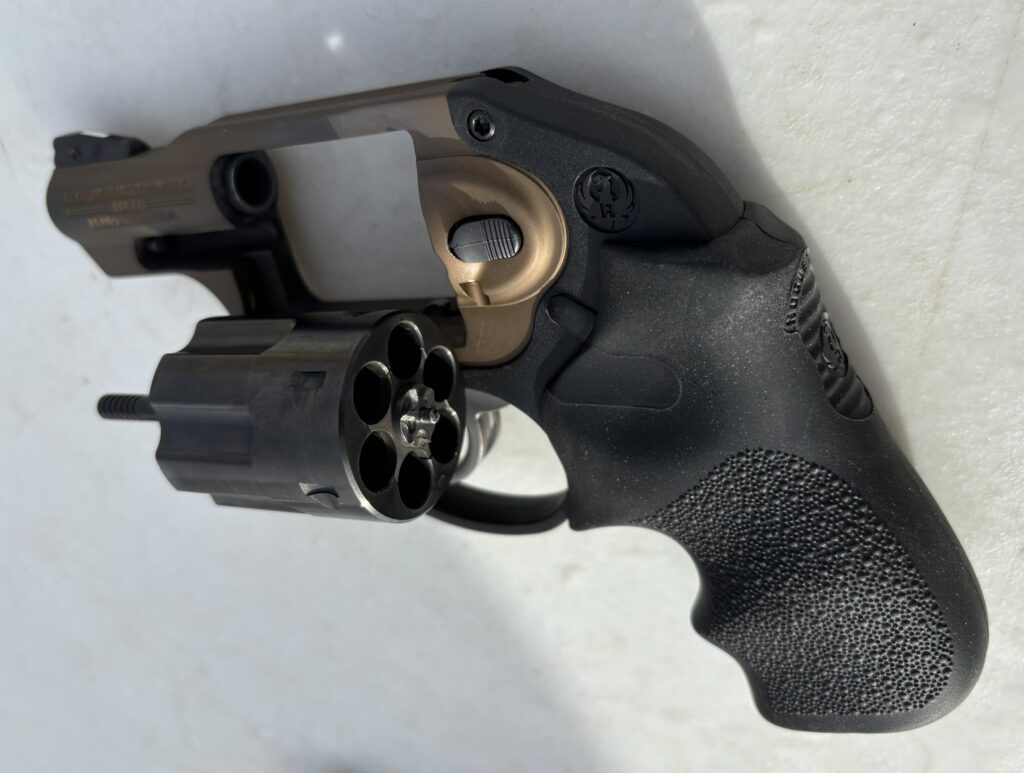
The .32 H&R Magnum Ruger LCR was probably the most popular of the bunch, and it didn’t spend much time on the table, as it was being passed from one shooter immediately to the next, without being set down. The .32 H&R Magnum is a great pairing for this gun, and everyone seemed to be pleased with how it shot in the lightweight snub. The bronze-colored frame—what Ruger had available at the time, to build the prototype, but the test shooters liked it so much that Lipsey’s decided to build all the production guns that way– was thought to be quite handsome by everyone who handled it.
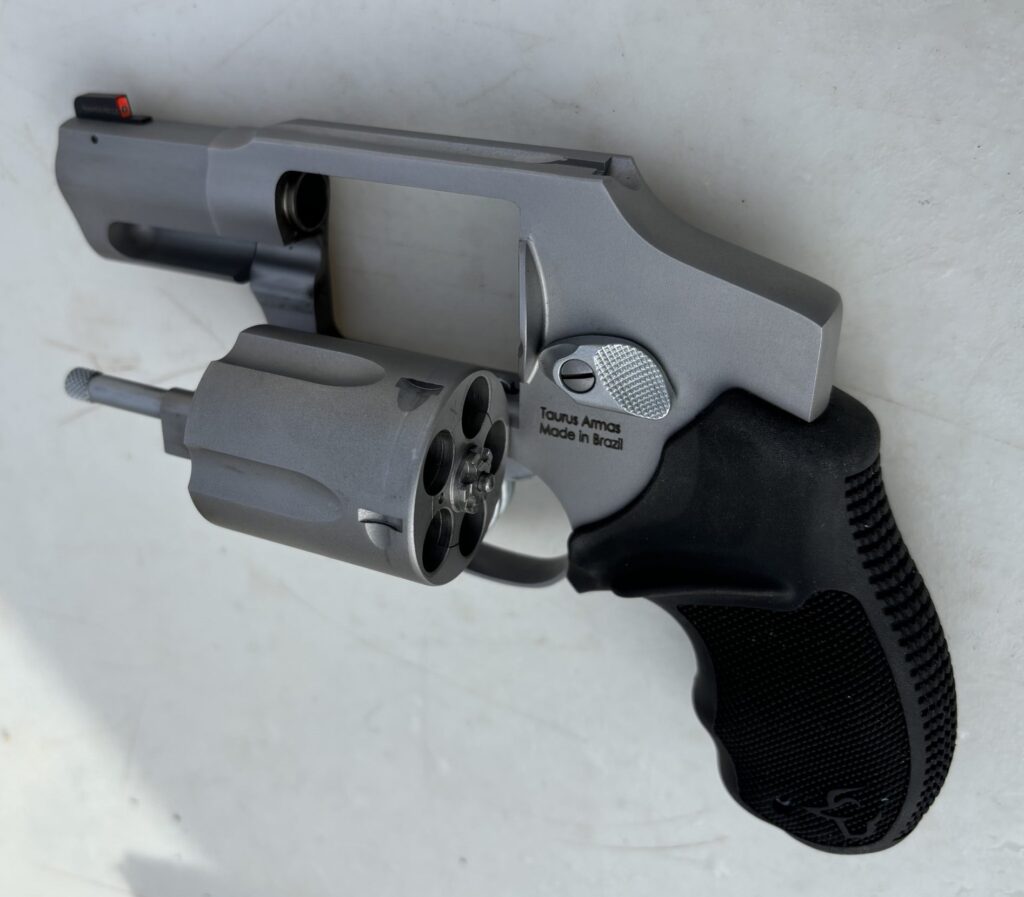
The Taurus 650 had already been cleaned up on the inside by Bryan, and was wearing a high-visibility Ameriglo sight up front (easy to change out, since the front sight is pinned in place–Bravo, Taurus!), so it wasn’t a fair look at the OEM product. However, with the light customization that had been performed, it was creeping into Smith & Wesson Model 640 territory, for about half the price. I think this one is going to sell very well, and I wouldn’t hesitate to recommend it to folks looking for an excellent .38 Special snub bargain (the gun is chambered in .357 Magnum, but who are we fooling, right? This is really an excellent .38+P, and we should leave the Magnums for the Medium Frame guns and larger).
A neat opportunity arose while I was on the range, courtesy of a generous RevolverGuy who let me take his S&W Model 58 for a test drive. This is a gun I’ve admired from afar for many, many decades, but I’d never had the opportunity to shoot one. I’d sent a number of .41 Mag Police Loads downrange through a 6” Model 57, but the Magnum M&P had eluded me to this point, so I was elated to get the chance to finally shoot one. Thank you, Gregory!
more fun and friends
At lunch on Monday, a prize raffle was held and some happy Roundup students went home with some great gear, to include SureFire lights, Galco holsters, Taurus revolvers, and Ruger revolvers (the .38 Special LCRs that students had been running in the outdoor and indoor simulators all weekend, under the watchful eyes of Gunsite instructors Freddie Blish, Lew Gosnell, and Erick Gelhaus), among other prizes. The Roundup participants raised over $6,000 for the Jeff Cooper Legacy Foundation, which will be used to fund scholarships for Gunsite students who need a little extra help to afford the tuition and expenses.
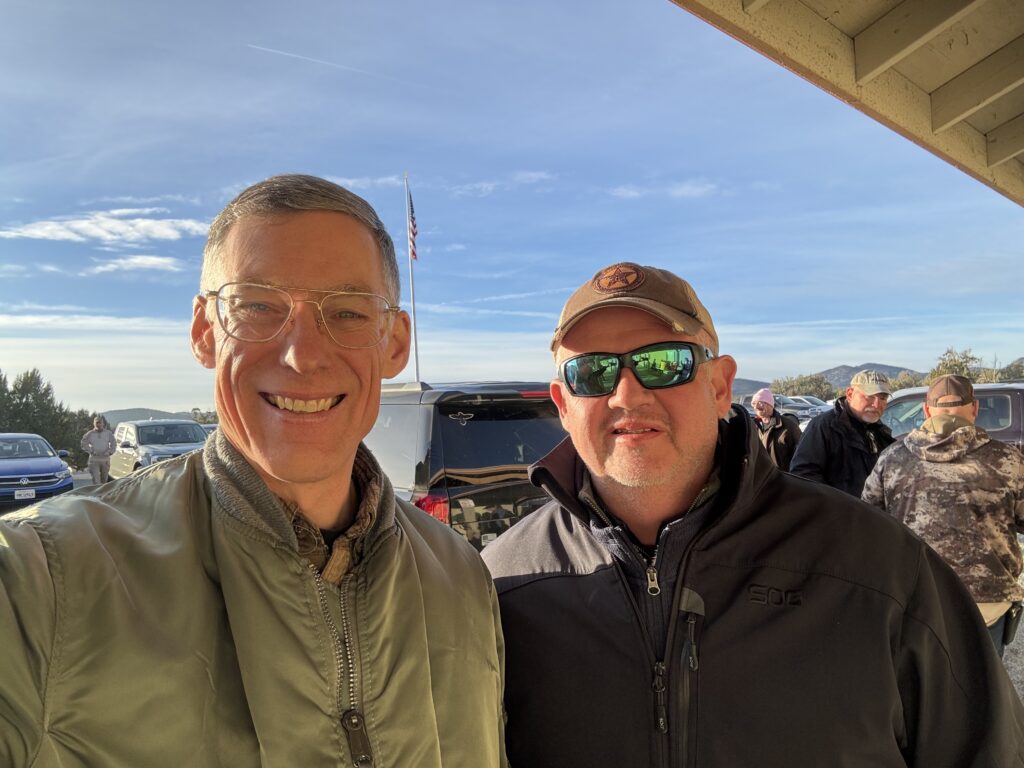
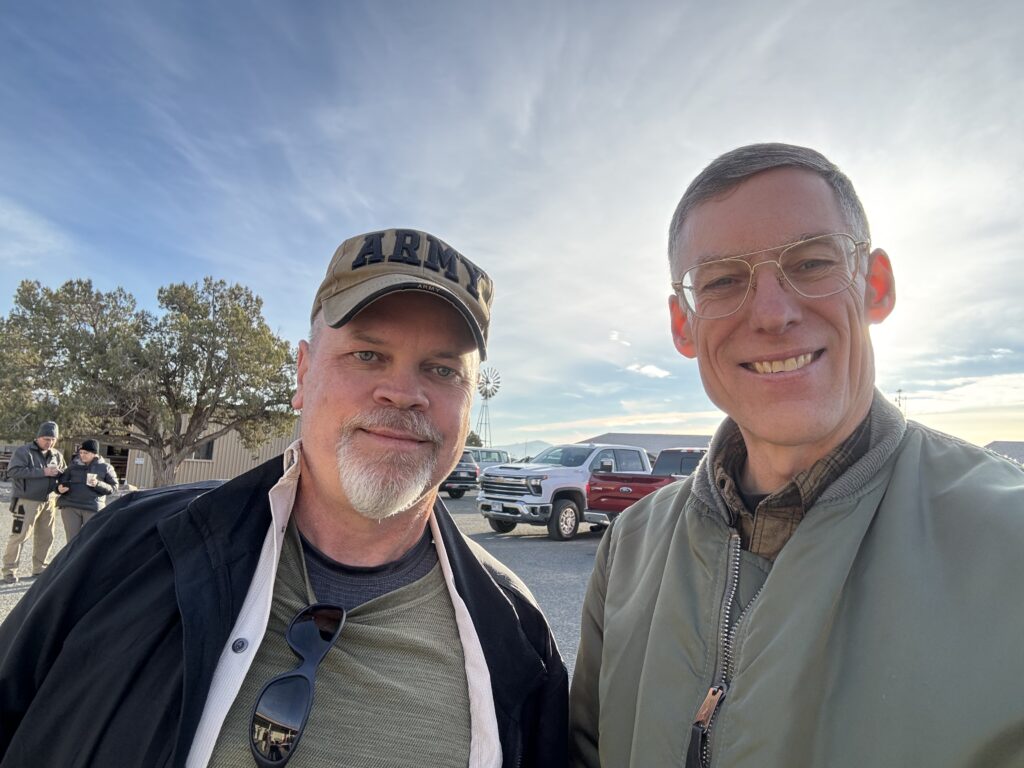
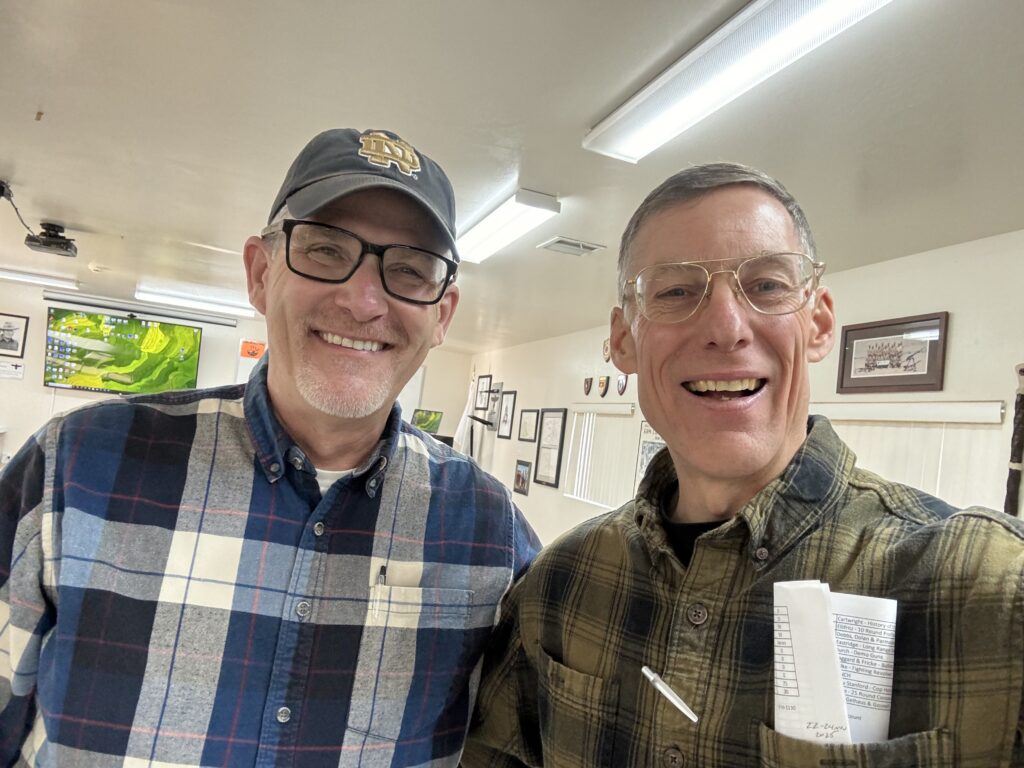
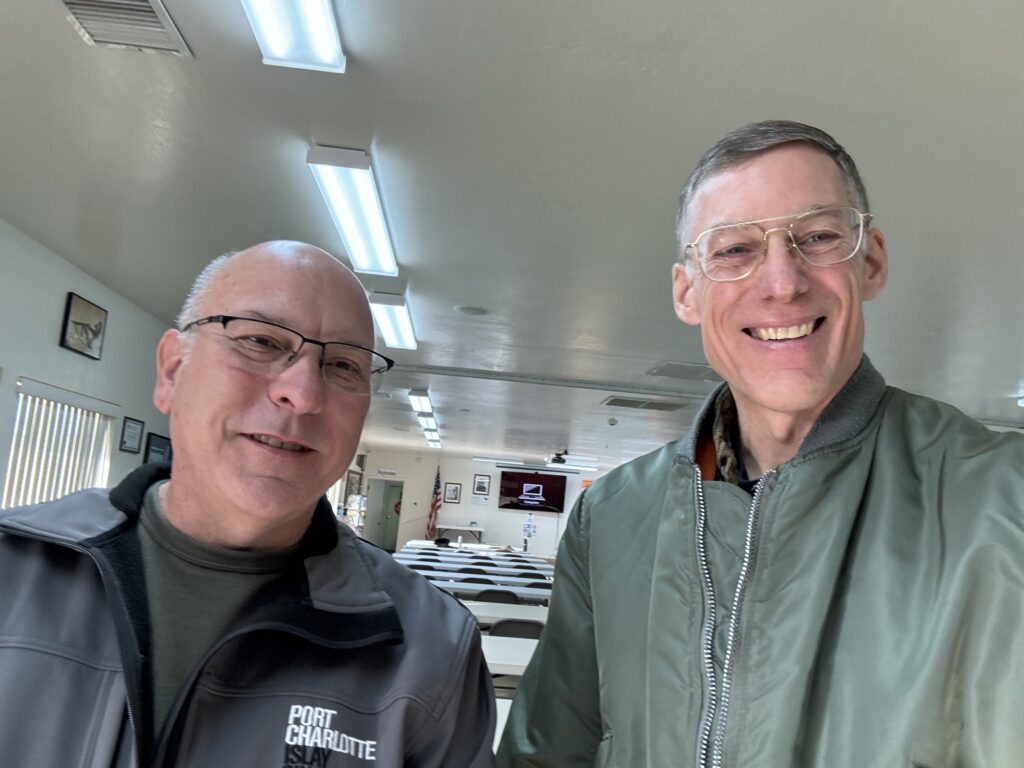
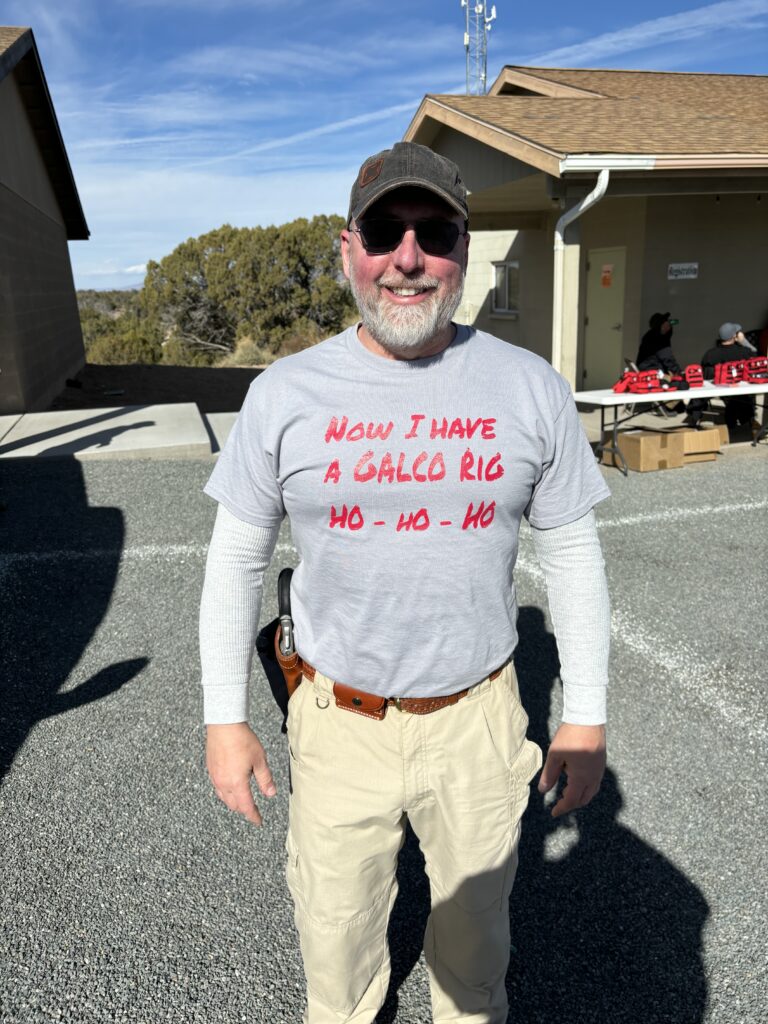
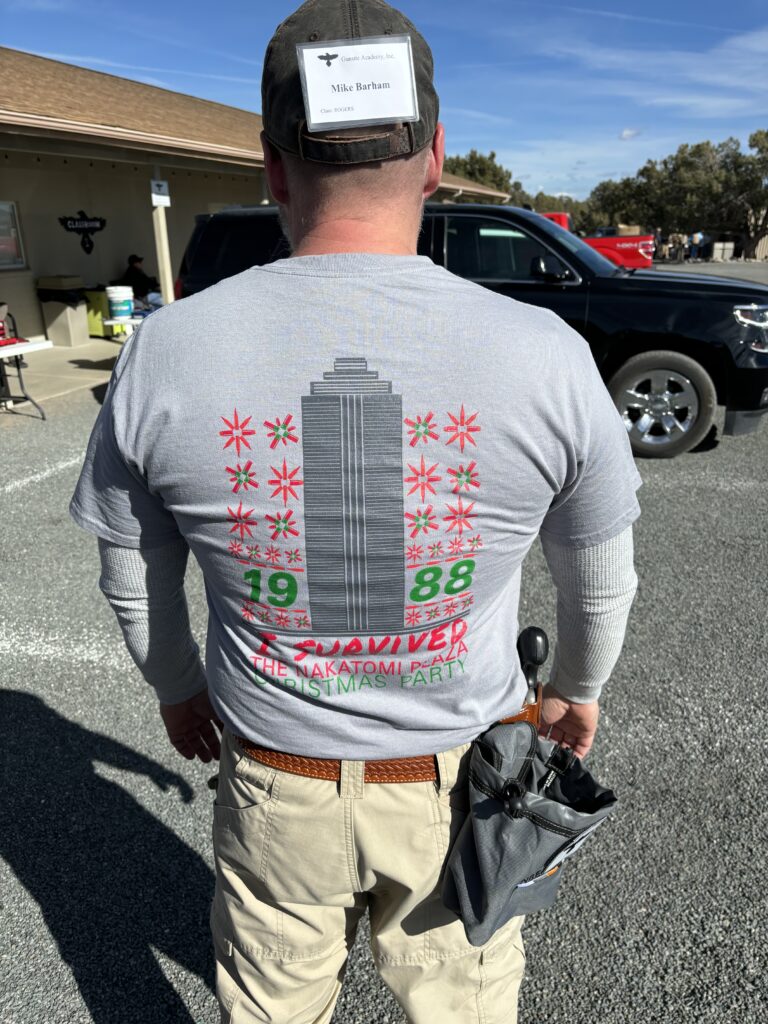
I took the opportunity to snap some photos with friends before going back into the classroom to teach the final Newhall lecture of the weekend on Monday afternoon. Many folks were hitting the road early to make the journey home to their families for Thanksgiving.
Before I knew it, another Roundup was in the books!
Get on it!
The Roundup sells out far in advance every year, so if you want to participate in the 2025 event, you need to get on Gunsite’s website and register for it immediately. I think DB&Y are hoping to add a few more seats in 2025, but there still won’t be enough to meet the expected demand for this excellent program.
So, if you want to go, get a move on, and register now!
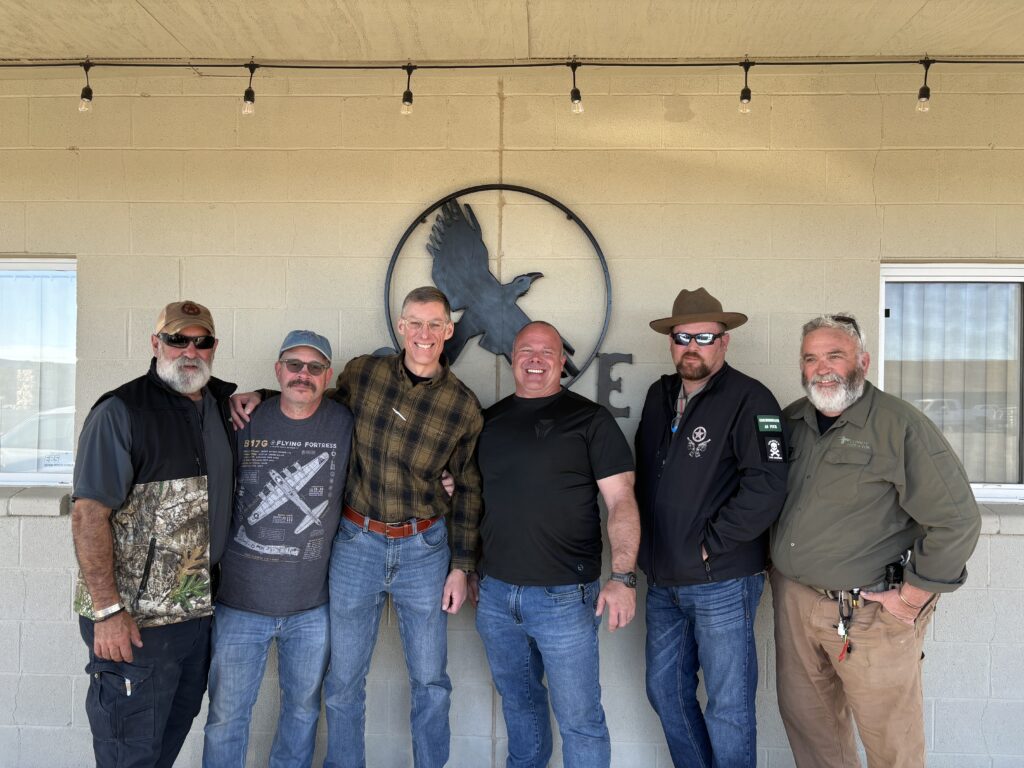
You may also want to head over to the American Fighting Revolver site and register for the RevolverFest 2025 event, which will be held on October 11, 12, and 13 in Clinton, South Carolina. RevolverFest is the East Coast equivalent of the Rogers Roundup, and will feature many of the same instructors and programs, so if Gunsite is too far to travel on the weekend before Thanksgiving, you’ll want to mark your calendars for the event in Clinton.
At either event, you’ll find some of the best revolver-focused instruction around, and will be surrounded by like-minded fans of these outstanding guns. I hope to see you there!

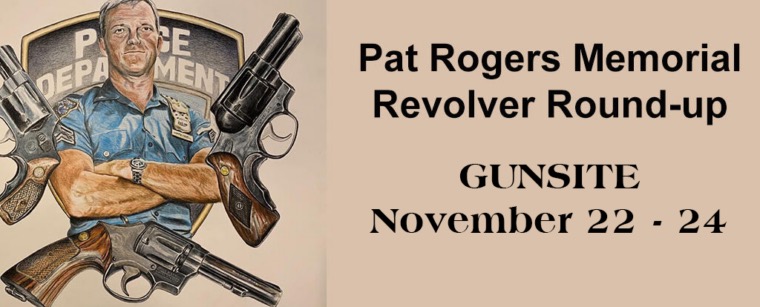
Great write-up as usual, Mike. The PRMRR is such a unique event – though there is certainly plenty of training going on for those who want to take advantage of it, it is also so much more than just a “training event.” It killed me not to be able to attend last year, but I signed up for the ’25 event the day after it was posted. Can’t wait to return to Gunsite.
For those of you who already run in avid wheelgunner circles, you probably know what this is all about. But if you are someone who is new to revolvers, or just wants to challenge their skills in new ways beyond the semi-auto world and want to become a more well-rounded shooter, I would highly encourage you to hit the Roundup – there is truly something for every skill level, and you may just make some great friends along the way.
Thanks Hammer. The Roundup is social first, training second, for most of us, and I like it that way! Looking forward to seeing you in November!
Mike,
Thanks for the article and the great memories. I particularly enjoyed your analysis on the Newhall shooting.
BTW – As I made my way back to Southern Maryland I flew out of Phoenix. Of course I declared my firearms in my checked luggage. As the TSA agent unlocked my gun case to inspect it, a big wide grin came across his face and he looked at my and exclaimed ‘Revolver Guy’! I said yep sure am and described my Gunsite Revolver Round up experience. The agent laughed and said ‘I’m a Revolver Guy too’!
Cheers, Joe
Hah! I love it, Joe! Hopefully he’ll join us for the next one.
Looking forward to seeing you again in November. Bringing your brother again?
Oh Yeah…a “must go” Mike.
Regards, The Other O’Hara
Glad to hear it, Bill! Look forward to seeing you there. Check Six!
Well, you may have dropped a round and lost ten points, but I appreciate the need to take a shot at the other guy’s fightin’ hand… and you did after all meet the standards. I say well aimed!
Hahaha! Thanks pal, it was all on purpose, you see . . .
Apparently Greg Ellifritz has had health problems of late but in your photos he looks as strong as ever. Hope all is well with him.
Sadly, Greg has cancer and the prognosis is not good, but he seems to be at peace with it, and is determined to enjoy life. I respect him greatly for how he’s handling it, and would ask our readers to keep him in their prayers.
He’s definitely an animal! I lift with guys like that at the gym, and know how much work it takes to stay that big! Much respect.
Any time one gets to participate in revolver-only events is a real treat. I hope I’m able to do Clinton, South Carolina, this fall . . . if Arthur Itis will permit me.
Getting old sucks, but it beats the alternative unless that alternative is enjoying wheelguns, and remembering the days when they were standard duty sidearms. That just makes me smile.
One of my favorite memories from the Colt Python Experience event was seeing a dozen-plus blued revolvers getting aimed downrange at the same time. It was good for the soul, brought me back to the “old days”
Great write up as always Mike. Mr Cartwrights class was awesome, and also a little humbling. I found that I really need to work on my 25 kneeling marksmanship. I usually shoot standing at 25 yards but I guess I haven’t shoot kneeling in years. I quickly found out that my “old man” bifocals weren’t working for me. I couldn’t get my head back far enough to see my sights, haha.
Thank you so much for posting the qualifications. I wrote down some of it, but must have gotten distracted and forgot to complete it in my notebook.
I showed Gavin this article this morning. He was happy that you caught a few pictures of us on the line that morning. I neglected to capture very many photos that day.
We were able to also go to Mr Ellifritz’s class that afternoon which was a really good teaching moment for both of us on reloading the gun.
We both would really love to attend another Revolver Round Up someday. I don’t think my son Gavin was expecting it to be such a good class or that he would learn anything. He now carries a revolver most of the time that he conceal carries, Kansas allows it at 18 with a license.
He has also fallen in love with Colts and has his eye on a new Colt Cobra.
Wade, I’m glad you guys enjoyed the Roundup so much, and also glad you enjoyed this review of it! That’s cool that I caught you guys on camera.
The new Cobras are great guns, and a fine choice for carry. I really like steel snubs, and don’t object to the extra weight. That puts me in the minority, but I really like the extra weight when it’s time to shoot, and a good holster goes a long way towards making it comfortable. I’ve never felt like I needed a 15 ounce Airweight, instead of my 21 ounce 640.
Concerning that 640, it’s odd that so many guys object to a mere extra six ounces of handgun weight. Many of my knives weigh a lot more than that and I don ‘t notice them when they’re in my pocket or on my belt.
Wade – I had the good luck of finding a new-ish Colt ‘Night Cobra’ model last year with the bobbed hammer and tritium front sight. They only made these for a short while after the new Cobras were introduced, and they haven’t been in the lineup for some time, but don’t hesitate if you (or Gavin) can find one. They are excellent carry options and very accurate shooters, for being snubs.
What a great event! I’m glad that you presented at this one, Mike. Yet another reason to put this awesome fellowship/training/show&tell/salute to Pat Rogers on the “must do” list. Hat tip to all that make it happen and continue to improve it.
Mike, Thank you for the excellent summary and photos. You captured both the content and vibe of the 2024 Roundup, and its predecessors. Your lecture on the Newhall Massacre is a must see for anyone who in a position to attend; the details are chilling, the lessons are lifesavers. Far too many qualified revolver instructors are leaving the field and I fear our generation may be the last to learn from those who actually survived life on the street with only six in the gun and twelve on the belt. Thanks again, Michael
Thank you Michael! I’m glad we have events like the Roundup to help capture that knowledge!
Newhall. That was a real game changer, forcing us to all keep it real. It reminds me of the FBI Miami shootout. Sometimes the numbers just keep on adding up the same way.
Have the results of the Haggard/Fricke gel tests for 2024 been published anywhere (other than FB, which I don’t use)?
Michael, I haven’t seen them. I don’t have any social media either, so can’t say if they’ve been published there.
I’ll check with Mark Fricke and will let you know.
Thanks, Mike. I look forward to their publication every year. I’ve seen many magic bullets and sacred cows sacrificed to the gel. Illuminating stuff.
Mike, your lecture on Newhall is a must attend for anyone going to Round Up.
Thank you Sir! That’s mighty praise, coming from you. Much appreciated!